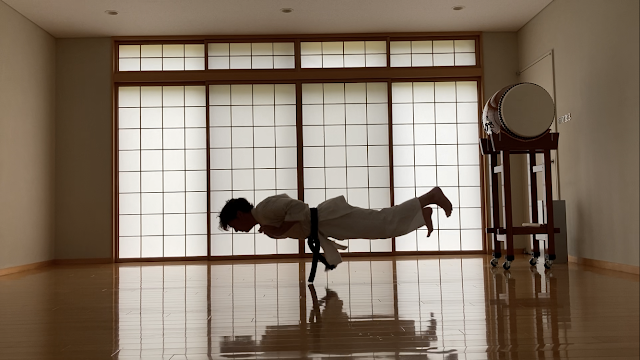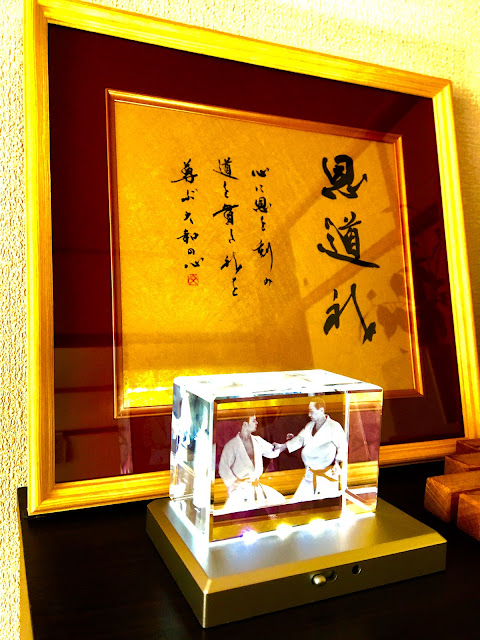..JPG)
基本
(KIHON)
その場基本
(Sonoba-Kihon)—Stationary Fundamentals
八字立
(1) 中段直突
(2) 三本連突
In hachiji-dachi assume hidari tateshuto chudan gamae. From
this position alternately practice chudan choku zuki. Follow this with sanbon
ren zuki (jodan zuki followed by chudan niren zuki).
• Note in
this practice I sometimes replace hachiji-dachi with 騎馬立 (kiba-dachi).
閉足立
(3) 中段前蹴蹴上
(4) 中段横蹴蹴上
Move into heisoku-dachi with gedan kakiwake. For technique
three simply practice chudan mae geri keage alternately. Once completed the
decided number of repetitions repeat this process with chudan yoko geri keage.
左前屈立
(5) 左上段刻突から右中段逆突
Drive forward into hidari zenkutsu dachi with hidari gedan
barai then slowly extend migi chudan gyaku-zuki as the preparatory kamae. From
this position practice hidari jodan kizami zuki followed by migi chudan gyaku
zuki.
右前屈立
(6) 右上段刻突から左中段逆突
This is the same practice as the previous waza except
mirrored; that is, practice migi jodan kizami zuki followed by hidari chudan
gyaku zuki in migi zenkutsu dachi.
左前屈立
(7) 右中段前蹴蹴上
(8) 左中段刻前蹴から右上段前蹴蹴上
In hidari zenkutsu dachi initially practice hidari chudan
mae geri keage in isolation, kicking then returning to hidari zenkutsu dachi.
After this practice execute hidari kizami mae geri followed by migi jodan mae
geri keage.
右前屈立
(9) 左中段前蹴蹴上
(10) 右中段刻前蹴から左上段前蹴蹴上
This practice is the same as techniques seven and eight, but
mirrored for balanced practice. In my case, if one side is weaker than the
other, I usually do more reps on the weaker side.
移動基本
(Ido-Kihon)—Fundamentals on the move
前屈立
(11) 三本連突
(12) 連蹴 (中段前蹴蹴上から上段前蹴蹴上)
(13) 回し蹴から中段逆突
(14) 中段後蹴蹴込
Techniques 11–14 are all attacking techniques advancing from
and into zenkutsu-dachi. The first is sanbon ren-zuki which comprises of jodan
oi-zuki followed by niren chudan-zuki (gyaku-zuki kara maete-zuki), which is a
combination of propulsion/drive followed by vibration/subtle rotation. The
second is two consecutive mae geri, the initial attacking chudan, with the
second waza going high. The third, technique 13, is ‘legs followed by hands:
Mawashi-geri then chudan gyaku-zuki. Technique 14 is Chudan ushiro-geri kekomi
in isolation.
騎馬立
(15) 中段横蹴蹴上、脚を変えて中段横蹴蹴込
This renwaza is executed from kiba-dachi. Use
kosa-aiyumibashi to advance with a lead leg chudan yoko-geri keage then
pivoting on the lead foot—towards the lead hip—use the rear leg to attack with
chudan yoko-geri kekomi.
前屈立
(16) 上段揚受から上段逆突
Fumidashi in zenkutsu-dachi with jodan age-uke followed by
jodan gyaku-zuki.
前屈立から騎馬立
(17) 中段外受から中段横猿臂
Fumidashi in zenkutsu-dachi with chudan soto-uchi then
transfer to zenkutsu-dachi with chudan yoko-enpi. Just to note, I’m presently
doing this renwaza without yori-ashi, which is very different for me, but
beneficial.
前屈立
(18) 中段内受から中段逆突
(19) 下段払から中段逆突
These two renwaza are in zenkutsu-dachi. The first is chudan
uchi-uke followed by chudan uchi-uke kara chudan gyaku-zuki; the second is the
same but the ukewaza is gedan-barai. Needless to say, both of these uke are
‘compression inward then expansion outward’ waza. The classical aim of the
chudan zuki is not to merely target the opponents abdomen, but to target their
spine.
後屈立から前屈立
(20) 手刀中段受から中段縦四本貫手
The final waza of my current idokihon training and total
kihon regime is simply transitioning from kokutsu-dachi to zenkutsu-dachi in
correspondence with shuto chudan-uke and chudan tate shihon nukite. The key
here is kakato chushin and driving forwards for the nukite.
型
(KATA)
i. Random 平安 (Heian). Today was Heian
Sandan. This is simply fundamental training at present. Very shallow
‘precision’ and ‘athleticism’ based practice.
ii. Random 鉄騎 (Tekki). I deviated in
today’s training and worked on both Nidan and Sandan focusing on overlapping
applicative points for infighting.
iii. One
kata from Shotokan’s ‘Big Seven’: for example, today was 半月 (Hangetsu) as some of
students are preparing it for an examination, and this spurred me to do it.
iv. 浪手 (Roshu) . This kata is a
jutsu for perfecting wave like actions in defense and offense. When practiced
properly it mimics the rise and fall of waves, swirling, ebbing and flowing
movement, which is not the wave itself but, rather, energy. This is one of the
many kata I learned privately, one on one, from Asai Tetsuhiko Sensei.
Appropriately, I state this today as it would have marked his 87th Birthday.
v. 安三 (Ansan) is a Tomari-Te
kata, which we have a very unique version of. Ansan is particularly focused on Atemi/Kyusho
jutsu.
組手
(KUMITE )
I’m presently focused on shadow boxing. That might sound
strange but my focus is on footwork (this coincidentally coincides with
Hangetsu), head movement, and intercepting ‘the shoot’; that is, neutralizing
‘being taken down’. In
addition to these points, I am also working on the aforementioned applications
from Tekki, Ansan, and the use of energy from Roshu.
© Andre Bertel. Oita City, Japan (2022).
..JPG)
..JPG)
..JPG)








..JPG)













